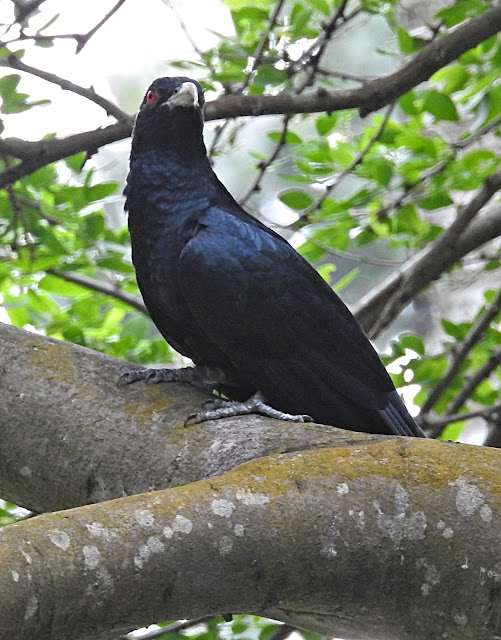The Asian koel (Eudynamys scolopaceus) is a member of the cuckoo order of birds, the Cuculiformes. It is found in the Indian Subcontinent, China, and Southeast Asia. It forms a superspecies with the closely related black-billed koels, and Pacific koels which are sometimes treated as subspecies. The Asian koel like many of its related cuckoo kin is a brood parasite that lays its eggs in the nests of crows and other hosts, who raise its young. They are unusual among the cuckoos in being largely frugivorous as adults. The name koel is echoic in origin with several language variants. The bird is a widely used symbol in Indian and Nepali poetry.
This Blog contains Wildlife, Plants and Bird Photos from Walks, Safaris, Birding Trips and Vacations. Most of the pictures have been taken with my Nikon P900 and P950X cameras. Just click on any image for a larger picture. On the right column under the Blog Archive are the entries by date. Below that under Animal categories all the diffent species of Animals, Birds, Insects and Plants contained in the website are listed. Clicking on any entry will show all the entries for that species.
TOTAL PAGEVIEWS
TRANSLATE
Showing posts with label ASIAN KOEL (MALE) (Eudynamys scolopaceu). Show all posts
Showing posts with label ASIAN KOEL (MALE) (Eudynamys scolopaceu). Show all posts
Tuesday, 9 January 2018
Tuesday, 25 October 2016
25-10-2016 SINGAPORE - ASIAN KOEL (MALE) (Eudynamys scolopaceu)
The Asian koel is a large and long-tailed cuckoo measuring 39–46 cm (15–18 in) and weighing 190–327 g (6.7–11.5 oz). The male of the nominate race is glossy bluish-black, with a pale greenish grey bill, the iris is crimson, and it has grey legs and feet. The female of the nominate race is brownish on the crown and has rufous streaks on the head. The back, rump and wing coverts are dark brown with white and buff spots. The underparts are whitish, but is heavily striped. The other subspecies differ in colouration and size. The upper plumage of young birds is more like that of the male and they have a black beak. They are very vocal during the breeding season (March to August in the Indian Subcontinent), with a range of different calls. The familiar song of the male is a repeated koo-Ooo. The female makes a shrill kik-kik-kik... call. Calls vary across populations.
The Asian koel is a bird of light woodland and cultivation. It is a mainly resident breeder in tropical southern Asia from Iran, Pakistan, India, Bangladesh and Sri Lanka to southern China and the Greater Sundas. They have great potential in colonizing new areas, and were among the pioneer birds to colonize the volcanic island of Krakatau. They first arrived in Singapore in the 1980s and became very common birds.
Some populations may make long-distance movements being found in places like Australia.
The Asian koel is a brood parasite, and lays its single egg in the nests of a variety of birds, including the jungle crow, and house crow. In Sri Lanka before 1880 it was only known to parasitize the jungle crow, later shifting to the house crow. A study in India found 5% of Corvus splendens and 0.5% of Corvus macrorhynchos nests parasitized.
The Asian koel is omnivorous, consuming a variety of insects, caterpillars, eggs and small vertebrates. Adults feed mainly on fruit. They will sometimes defend fruiting trees that they forage in and chase away other frugivores. They have been noted to be especially important in the dispersal of the sandalwood tree (Santalum album) in India. Large seeded fruits are sometimes quickly regurgitated near the parent tree while small seeded fruits are ingested and are likely to be deposited at greater distances from the parent tree. They have a large gape and are capable of swallowing large fruits including the hard fruit of palms such as Arenga and Livistona. They have been known to occasionally take eggs of small birds.
They feed on the fruits of Cascabela thevetia which are known to be toxic to mammals.
A number of parasites of the species have been described, including malaria-like protozoa, lice and nematodes.
Subscribe to:
Comments (Atom)




%20(Eudynamys%20scolopaceu)%2010.jpg)